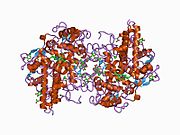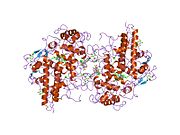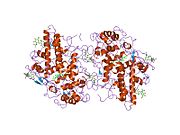Myeloperoxidase
| Myeloperoxidase | |||||||||
|---|---|---|---|---|---|---|---|---|---|
| Identifiers | |||||||||
| EC no. | 1.11.2.2 | ||||||||
| Databases | |||||||||
| IntEnz | IntEnz view | ||||||||
| BRENDA | BRENDA entry | ||||||||
| ExPASy | NiceZyme view | ||||||||
| KEGG | KEGG entry | ||||||||
| MetaCyc | metabolic pathway | ||||||||
| PRIAM | profile | ||||||||
| PDB structures | RCSB PDB PDBe PDBsum | ||||||||
| |||||||||
Myeloperoxidase (MPO) is a peroxidase enzyme that in humans is encoded by the MPO gene on chromosome 17.[5] MPO is most abundantly expressed in neutrophil granulocytes (a subtype of white blood cells), and produces hypohalous acids to carry out their antimicrobial activity, including hypochlorous acid, the sodium salt of which is the chemical in bleach.[5][6] It is a lysosomal protein stored in azurophilic granules of the neutrophil and released into the extracellular space during degranulation.[7] Neutrophil myeloperoxidase has a heme pigment, which causes its green color in secretions rich in neutrophils, such as mucus and sputum.[8] The green color contributed to its outdated name verdoperoxidase.
EC Number
The EC number of myeloperoxidase (MPO) is 1.11.2.2. The first digit, 1, places the enzyme into a class the class which catalyzes oxidoreductase reactions. The second digit, 11, classifies the enzyme as a peroxidase. The final digits, 2 and 2 identify specifically myeloperoxidase.
Reaction Pathway
The major reaction myeloperoxidase catalyzes is the conversion of hydrogen peroxide and chloride ions into hypochlorous acid. To achieve this, myeloperoxidase uses hydrogen peroxide as an electron acceptor (for breakdown) and chloride ions as substrates.[9] This all occurs within a neutrophil cell, which is important for innate immune function. The first part of the reaction pathway is when the heme group of the myeloperoxidase is converted to an activated heme called Compound I when hydrogen peroxide donates an oxygen to myeloperoxidase. This compound then oxidizes the chloride ions to form the hypochlorous acid and Compound II, which can be reduced back down to its original heme state. This cycle continues for as long as the immune system requires. The myeloperoxidase activity within the phagosome of the neutrophil is conducive to the breakdown of pathogens, as hypochlorous acid is an effective antimicrobial agent.
Structure
The 150-kDa MPO protein is a cationic heterotetramer consisting of two 15-kDa light chains and two variable-weight glycosylated heavy chains bound to a prosthetic heme group complex with calcium ions, arranged as a homodimer of heterodimers.[10][11][12][13] The light chains are glycosylated and contain the modified iron protoporphyrin IX active site. Together, the light and heavy chains form two identical 73-kDa monomers connected by a cystine bridge at Cys153. The protein forms a deep crevice which holds the heme group at the bottom, as well as a hydrophobic pocket at the entrance to the distal heme cavity which carries out its catalytic activity.[13]
Three isoforms have been identified, differing only in the size of the heavy chains.[11]
One of the ligands is the carbonyl group of Asp 96. Calcium-binding is important for structure of the active site because of Asp 96's close proximity to the catalytic His95 side chain.[14]
Function
Myeloperoxidase's main functions are within the immune system, functioning to essentially destroy pathogens. The way this works is that they are released from granules within the neutrophil into the phagosome for breakdown of pathogens. It does this by, as described before, catalysis of hydrogen peroxide into hypochlorous acid. This hypochlorous acid, along with destruction of pathogens, can also initiate and regulate inflammatory response.[15] Inflammatory response affects metabolic pathways when activating immune cells. In order to provide energy necessary for inflammatory response, glycolysis is upregulated to provide ATP for phagocytosis. Following phagocytosis, the immune cells repair and remodel tissues, which can be aided by oxidized products of myeloperoxidase function.
MPO is a member of the XPO subfamily of peroxidases and produces hypochlorous acid (HOCl) from hydrogen peroxide (H2O2) and chloride anion (Cl−) (or hypobromous acid if Br- is present) during the neutrophil's respiratory burst. It requires heme as a cofactor. Furthermore, it oxidizes tyrosine to tyrosyl radical using hydrogen peroxide as an oxidizing agent.[11][16] Hypochlorous acid and tyrosyl radical are cytotoxic, so they are used by the neutrophil to kill bacteria and other pathogens.[17] However, this hypochlorous acid may also cause oxidative damage in host tissue. Moreover, MPO oxidation of apoA-I reduces HDL-mediated inhibition of apoptosis and inflammation.[18] In addition, MPO mediates protein nitrosylation and the formation of 3-chlorotyrosine and dityrosine crosslinks.[11]
Structure Effect on Function
As described before, the structure of myeloperoxidase is integral to its function. The central heme group acts as the active site for chloride ions and hydrogen peroxide.[13] This is also the site of electron transfer, which allows myeloperoxidase to convert the two into hypochlorous acid. This allows the main function of myeloperoxidase, breakdown of pathogens, to occur.
Crystal Structure
There are many variations of the myeloperoxidase 3D structure, however they all follow a specific pattern. The myeloperoxidase enzyme typically weighs within the 135-200 kDa range, depending on the varying heavy chains it can be bound to.[19] The enzyme is a heterotetramer with two light chains (15 kDa) and two glycosylated heavy chains which cause variability in weight. These heavy chains are bound to a heme group complex with calcium ions, arranged as a homodimer of heterodimers.[10] The light and heavy chain monomers are connected by a cystine bridge at Cys153.
Active Sites
The heme group containing a central iron atom functions as the active site for myeloperoxidase. This heme group is active in the oxidoreductase activity on hydrogen peroxide. This is also where substrate (Cl- ions) and hydrogen peroxide may bind. This results in a reaction with the heme iron, and the chloride ions help form hypochlorous acid. Amino acid residues participate in the transfer of electrons during the reaction catalyzed by myeloperoxidase.[9]
Organisms containing Myeloperoxidase
Myeloperoxidase is currently found in many different organisms including mammals, birds, fish, reptiles, and amphibians. Myeloperoxidase deficiency is a well-documented disease among humans resulting in impaired immune function.[20]
Clinical significance
Myeloperoxidase deficiency is a hereditary deficiency of the enzyme, which predisposes to immune deficiency.[21]
Antibodies against MPO have been implicated in various types of vasculitis, most prominently three clinically and pathologically recognized forms: granulomatosis with polyangiitis (GPA), microscopic polyangiitis (MPA); and eosinophilic granulomatosis with polyangiitis (EGPA). Antibodies are also known as anti-neutrophil cytoplasmic antibodies (ANCAs), though ANCAs have also been detected in staining of the perinuclear region.[22]
Recent studies have reported an association between elevated myeloperoxidase levels and the severity of coronary artery disease.[23] And Heslop et al. reported that elevated MPO levels more than doubled the risk for cardiovascular mortality over a 13-year period.[24] It has also been suggested that myeloperoxidase plays a significant role in the development of the atherosclerotic lesion and rendering plaques unstable.[25][26]
Medical uses
An initial 2003 study suggested that MPO could serve as a sensitive predictor for myocardial infarction in patients presenting with chest pain.[27] Since then, there have been over 100 published studies documenting the utility of MPO testing. The 2010 Heslop et al. study reported that measuring both MPO and CRP (C-reactive protein; a general and cardiac-related marker of inflammation) provided added benefit for risk prediction than just measuring CRP alone.[24]
Immunohistochemical staining for myeloperoxidase used to be administered in the diagnosis of acute myeloid leukemia to demonstrate that the leukemic cells were derived from the myeloid lineage. Myeloperoxidase staining is still important in the diagnosis of myeloid sarcoma, contrasting with the negative staining of lymphomas, which can otherwise have a similar appearance.[28] In the case of screening patients for vasculitis, flow cytometric assays have demonstrated comparable sensitivity to immunofluorescence tests, with the additional benefit of simultaneous detection of multiple autoantibodies relevant to vasculitis. Nonetheless, this method still requires further testing.[29]
Myeloperoxidase is the first and so far only human enzyme known to break down carbon nanotubes, allaying a concern among clinicians that using nanotubes for targeted delivery of medicines would lead to an unhealthy buildup of nanotubes in tissues.[30]
Inhibitors of MPO
Azide has been used traditionally as an MPO inhibitor, but 4-aminobenzoic acid hydrazide (4-ABH) is a more specific inhibitor of MPO.[31]
See also
References
- ^ a b c GRCh38: Ensembl release 89: ENSG00000005381 – Ensembl, May 2017
- ^ a b c GRCm38: Ensembl release 89: ENSMUSG00000009350 – Ensembl, May 2017
- ^ "Human PubMed Reference:". National Center for Biotechnology Information, U.S. National Library of Medicine.
- ^ "Mouse PubMed Reference:". National Center for Biotechnology Information, U.S. National Library of Medicine.
- ^ a b "Entrez Gene: Myeloperoxidase".
- ^ Klebanoff SJ (May 2005). "Myeloperoxidase: friend and foe". Journal of Leukocyte Biology. 77 (5): 598–625. doi:10.1189/jlb.1204697. PMID 15689384. S2CID 12489688.
- ^ Kinkade JM, Pember SO, Barnes KC, Shapira R, Spitznagel JK, Martin LE (Jul 1983). "Differential distribution of distinct forms of myeloperoxidase in different azurophilic granule subpopulations from human neutrophils". Biochemical and Biophysical Research Communications. 114 (1): 296–303. doi:10.1016/0006-291x(83)91627-3. PMID 6192815.
- ^ Le T, Bhushan V, Sochat M, Damisch K, Abrams J, Kallianos K, Boqambar H, Qiu, C, Coleman C (2021). First Aid for the USMLE Step 1 (2021 ed.). New York: McGraw Hill. p. 109. ISBN 9781260467529.
- ^ a b Aratani Y (February 2018). "Myeloperoxidase: Its role for host defense, inflammation, and neutrophil function". Archives of Biochemistry and Biophysics. 640: 47–52. doi:10.1016/j.abb.2018.01.004. PMID 29336940.
- ^ a b Davey CA, Fenna RE (August 1996). "2.3 A resolution X-ray crystal structure of the bisubstrate analogue inhibitor salicylhydroxamic acid bound to human myeloperoxidase: a model for a prereaction complex with hydrogen peroxide". Biochemistry. 35 (33): 10967–10973. doi:10.1021/bi960577m. PMID 8718890.
- ^ a b c d "Mouse MPO EasyTestTM ELISA Kit" (PDF). Archived from the original (PDF) on 2016-03-03. Retrieved 2015-08-06.
- ^ Mathy-Hartert M, Bourgeois E, Grülke S, Deby-Dupont G, Caudron I, Deby C, et al. (April 1998). "Purification of myeloperoxidase from equine polymorphonuclear leucocytes". Canadian Journal of Veterinary Research = Revue Canadienne De Recherche Veterinaire. 62 (2): 127–132. PMC 1189459. PMID 9553712.
- ^ a b c Davies MJ (January 2011). "Myeloperoxidase-derived oxidation: mechanisms of biological damage and its prevention". Journal of Clinical Biochemistry and Nutrition. 48 (1): 8–19. doi:10.3164/jcbn.11-006FR. PMC 3022070. PMID 21297906.
- ^ Shin K, Hayasawa H, Lönnerdal B (Mar 2001). "Mutations affecting the calcium-binding site of myeloperoxidase and lactoperoxidase". Biochemical and Biophysical Research Communications. 281 (4): 1024–9. doi:10.1006/bbrc.2001.4448. PMID 11237766.
- ^ Davies MJ (February 2021). "Myeloperoxidase: Mechanisms, reactions and inhibition as a therapeutic strategy in inflammatory diseases". Pharmacology & Therapeutics. 218: 107685. doi:10.1016/j.pharmthera.2020.107685. PMID 32961264.
- ^ Heinecke JW, Li W, Francis GA, Goldstein JA (Jun 1993). "Tyrosyl radical generated by myeloperoxidase catalyzes the oxidative cross-linking of proteins". The Journal of Clinical Investigation. 91 (6): 2866–72. doi:10.1172/JCI116531. PMC 443356. PMID 8390491.
- ^ Hampton MB, Kettle AJ, Winterbourn CC (Nov 1998). "Inside the neutrophil phagosome: oxidants, myeloperoxidase, and bacterial killing". Blood. 92 (9): 3007–17. doi:10.1182/blood.V92.9.3007. PMID 9787133.
- ^ Shao B, Oda MN, Oram JF, Heinecke JW (Mar 2010). "Myeloperoxidase: an oxidative pathway for generating dysfunctional high-density lipoprotein". Chemical Research in Toxicology. 23 (3): 447–54. doi:10.1021/tx9003775. PMC 2838938. PMID 20043647.
- ^ Shaw SA, Vokits BP, Dilger AK, Viet A, Clark CG, Abell LM, et al. (November 2020). "Discovery and structure activity relationships of 7-benzyl triazolopyridines as stable, selective, and reversible inhibitors of myeloperoxidase". Bioorganic & Medicinal Chemistry. 28 (22): 115723. doi:10.1016/j.bmc.2020.115723. PMID 33007547.
- ^ "Myeloperoxidase - an overview | ScienceDirect Topics". www.sciencedirect.com. Retrieved 2023-10-23.
- ^ Kutter D, Devaquet P, Vanderstocken G, Paulus JM, Marchal V, Gothot A (2000). "Consequences of total and subtotal myeloperoxidase deficiency: risk or benefit ?". Acta Haematologica. 104 (1): 10–5. doi:10.1159/000041062. PMID 11111115. S2CID 36776058.
- ^ Flint SM, McKinney EF, Smith KG (Mar 2015). "Emerging concepts in the pathogenesis of antineutrophil cytoplasmic antibody-associated vasculitis". Current Opinion in Rheumatology. 27 (2): 197–203. doi:10.1097/BOR.0000000000000145. PMID 25629443. S2CID 20296651.
- ^ Zhang R, Brennan ML, Fu X, Aviles RJ, Pearce GL, Penn MS, Topol EJ, Sprecher DL, Hazen SL (Nov 2001). "Association between myeloperoxidase levels and risk of coronary artery disease". JAMA. 286 (17): 2136–42. doi:10.1001/jama.286.17.2136. PMID 11694155.
- ^ a b Heslop CL, Frohlich JJ, Hill JS (Mar 2010). "Myeloperoxidase and C-reactive protein have combined utility for long-term prediction of cardiovascular mortality after coronary angiography". Journal of the American College of Cardiology. 55 (11): 1102–9. doi:10.1016/j.jacc.2009.11.050. PMID 20223364.
- ^ Nicholls SJ, Hazen SL (Jun 2005). "Myeloperoxidase and cardiovascular disease". Arteriosclerosis, Thrombosis, and Vascular Biology. 25 (6): 1102–11. doi:10.1161/01.ATV.0000163262.83456.6d. PMID 15790935.
- ^ Lau D, Baldus S (Jul 2006). "Myeloperoxidase and its contributory role in inflammatory vascular disease". Pharmacology & Therapeutics. 111 (1): 16–26. doi:10.1016/j.pharmthera.2005.06.023. PMID 16476484.
- ^ Brennan ML, Penn MS, Van Lente F, Nambi V, Shishehbor MH, Aviles RJ, Goormastic M, Pepoy ML, McErlean ES, Topol EJ, Nissen SE, Hazen SL (Oct 2003). "Prognostic value of myeloperoxidase in patients with chest pain". The New England Journal of Medicine. 349 (17): 1595–604. doi:10.1056/NEJMoa035003. PMID 14573731. S2CID 22084078.
- ^ Leong AS, Cooper K, Leong, FJ (2003). Manual of Diagnostic Antibodies for Immunohistology. London: Greenwich Medical Media. pp. 325–326. ISBN 1-84110-100-1.
- ^ Csernok E, Moosig F (Aug 2014). "Current and emerging techniques for ANCA detection in vasculitis". Nature Reviews. Rheumatology. 10 (8): 494–501. doi:10.1038/nrrheum.2014.78. PMID 24890776. S2CID 25292707.
- ^ Kagan VE, Konduru NV, Feng W, Allen BL, Conroy J, Volkov Y, Vlasova II, Belikova NA, Yanamala N, Kapralov A, Tyurina YY, Shi J, Kisin ER, Murray AR, Franks J, Stolz D, Gou P, Klein-Seetharaman J, Fadeel B, Star A, Shvedova AA (May 2010). "Carbon nanotubes degraded by neutrophil myeloperoxidase induce less pulmonary inflammation". Nature Nanotechnology. 5 (5): 354–9. Bibcode:2010NatNa...5..354K. doi:10.1038/nnano.2010.44. PMC 6714564. PMID 20364135.
- Clay Dillow (April 6, 2010). "Scientists Devise A Means For Human Bodies To Break Down Carbon Nanotubes". Popular Science.
- ^ Kettle AJ, Gedye CA, Winterbourn CC (Jan 1997). "Mechanism of inactivation of myeloperoxidase by 4-aminobenzoic acid hydrazide". The Biochemical Journal. 321. 321 (2): 503–8. doi:10.1042/bj3210503. PMC 1218097. PMID 9020887.













